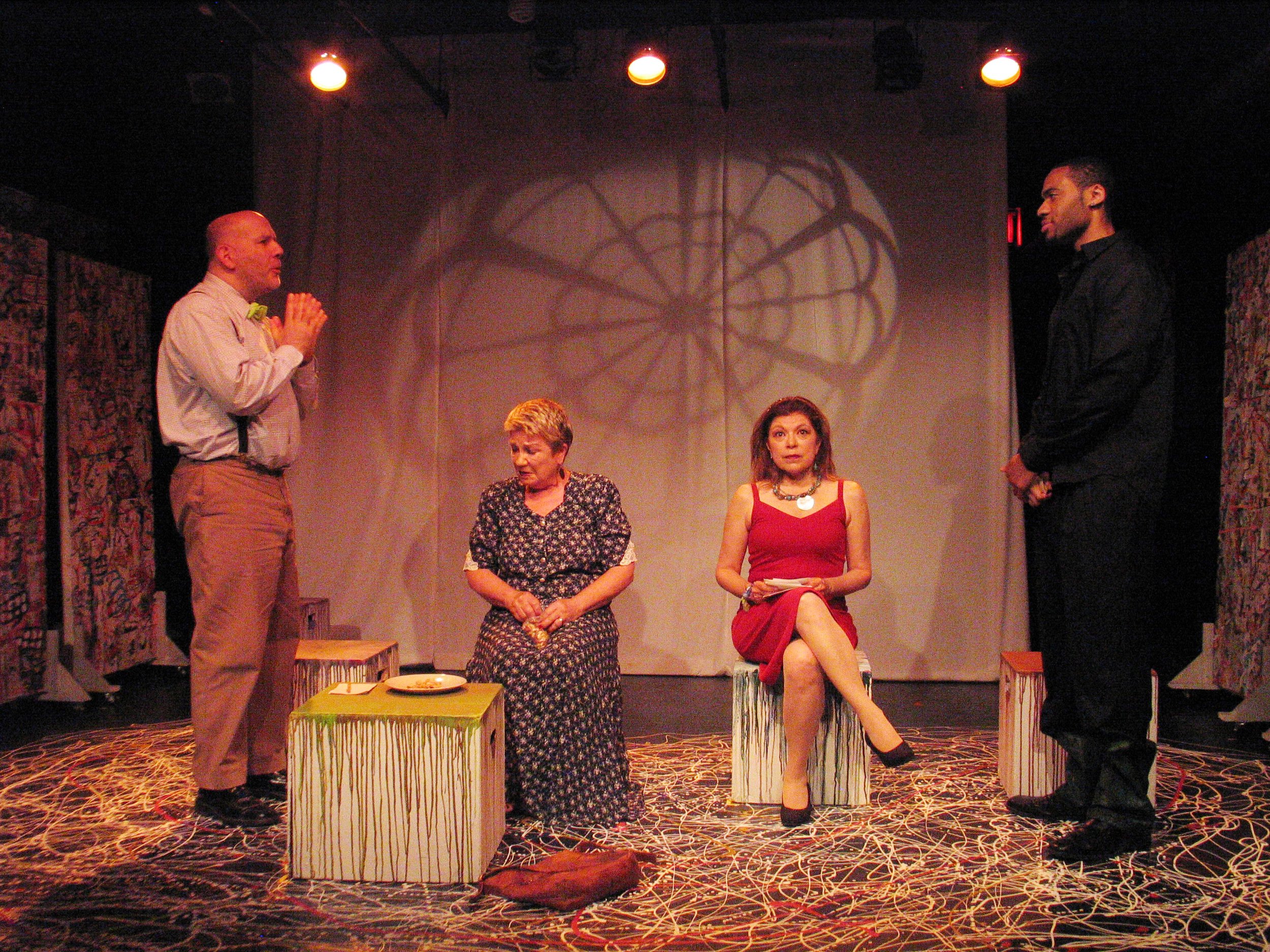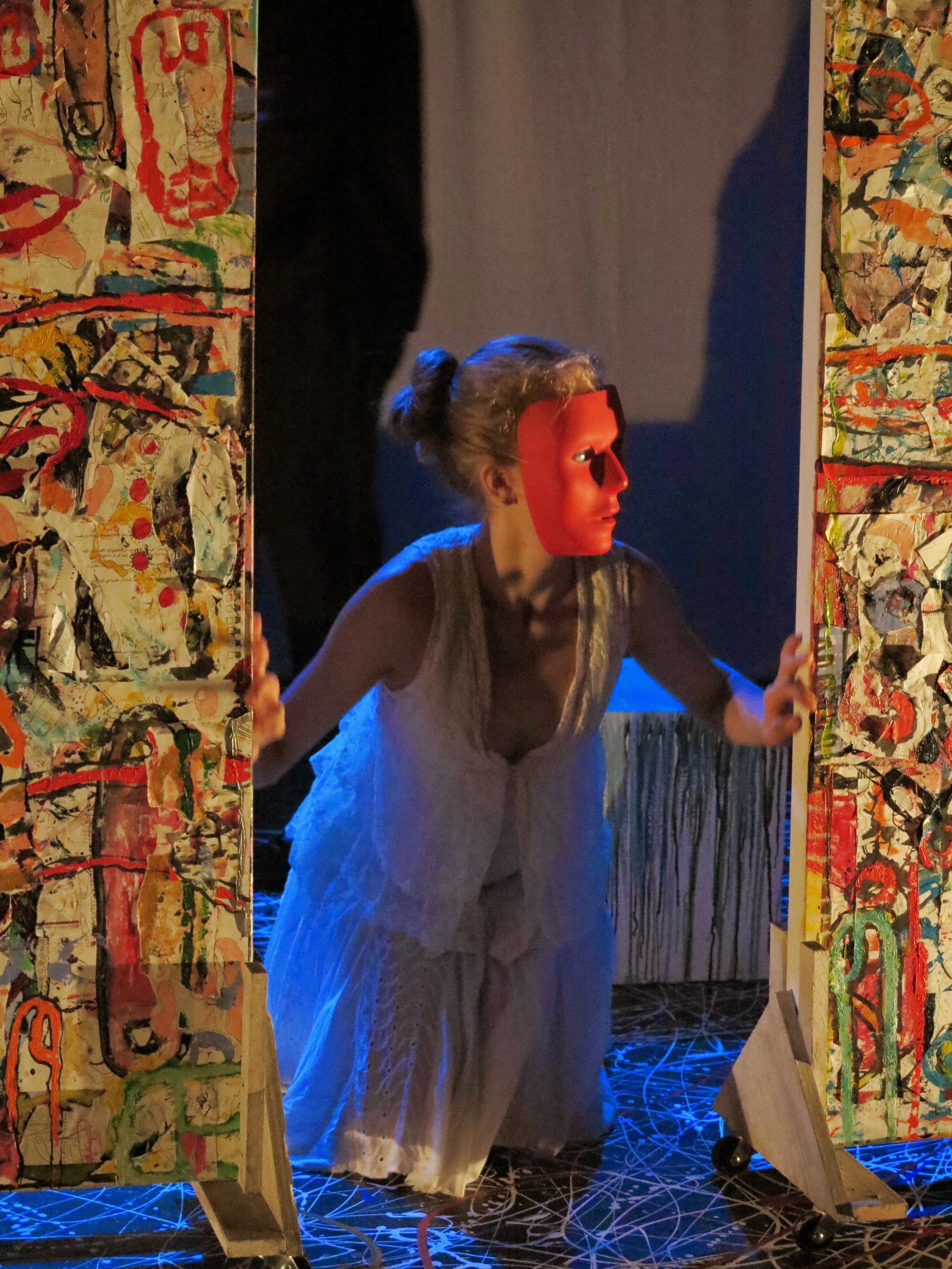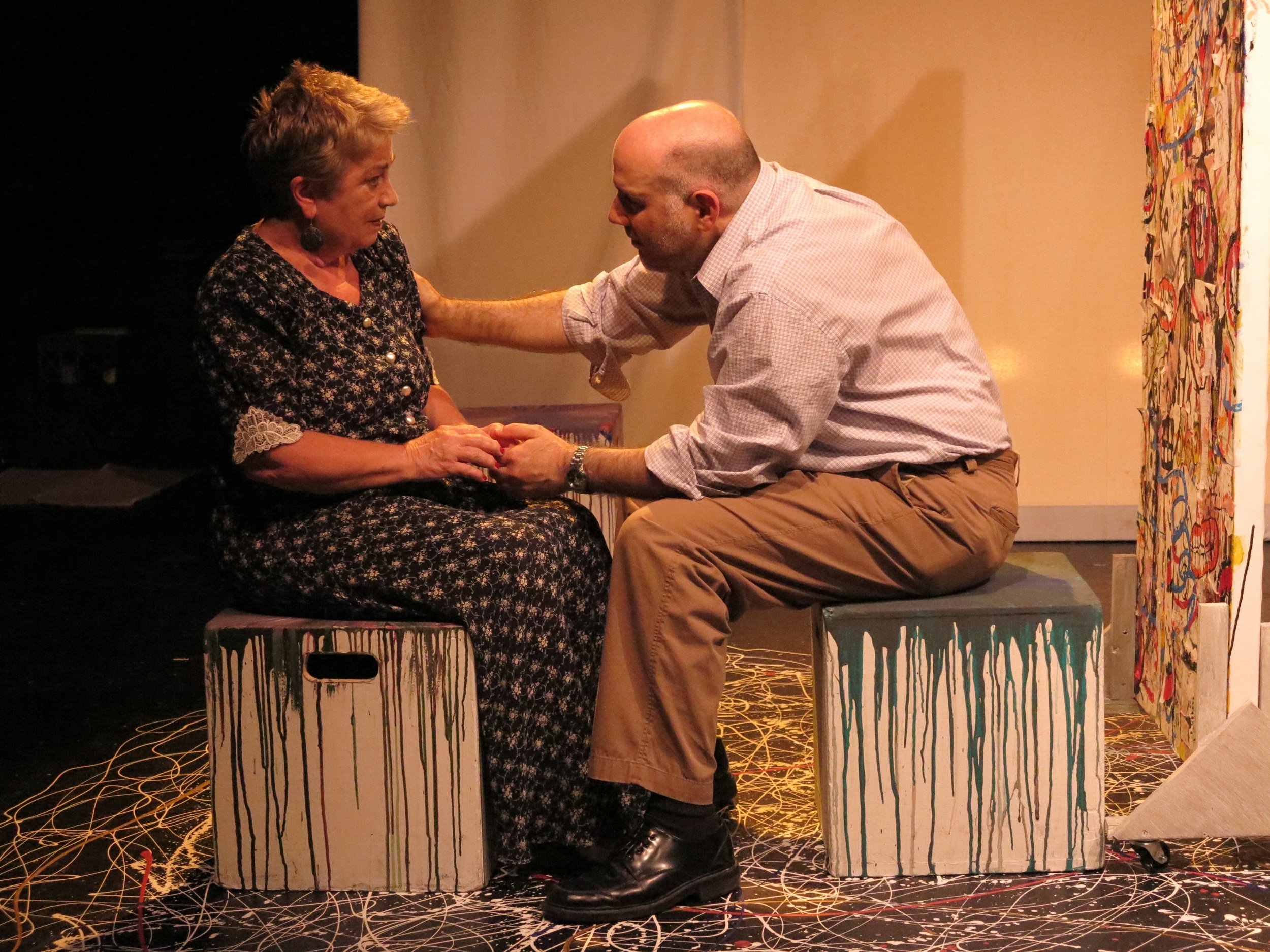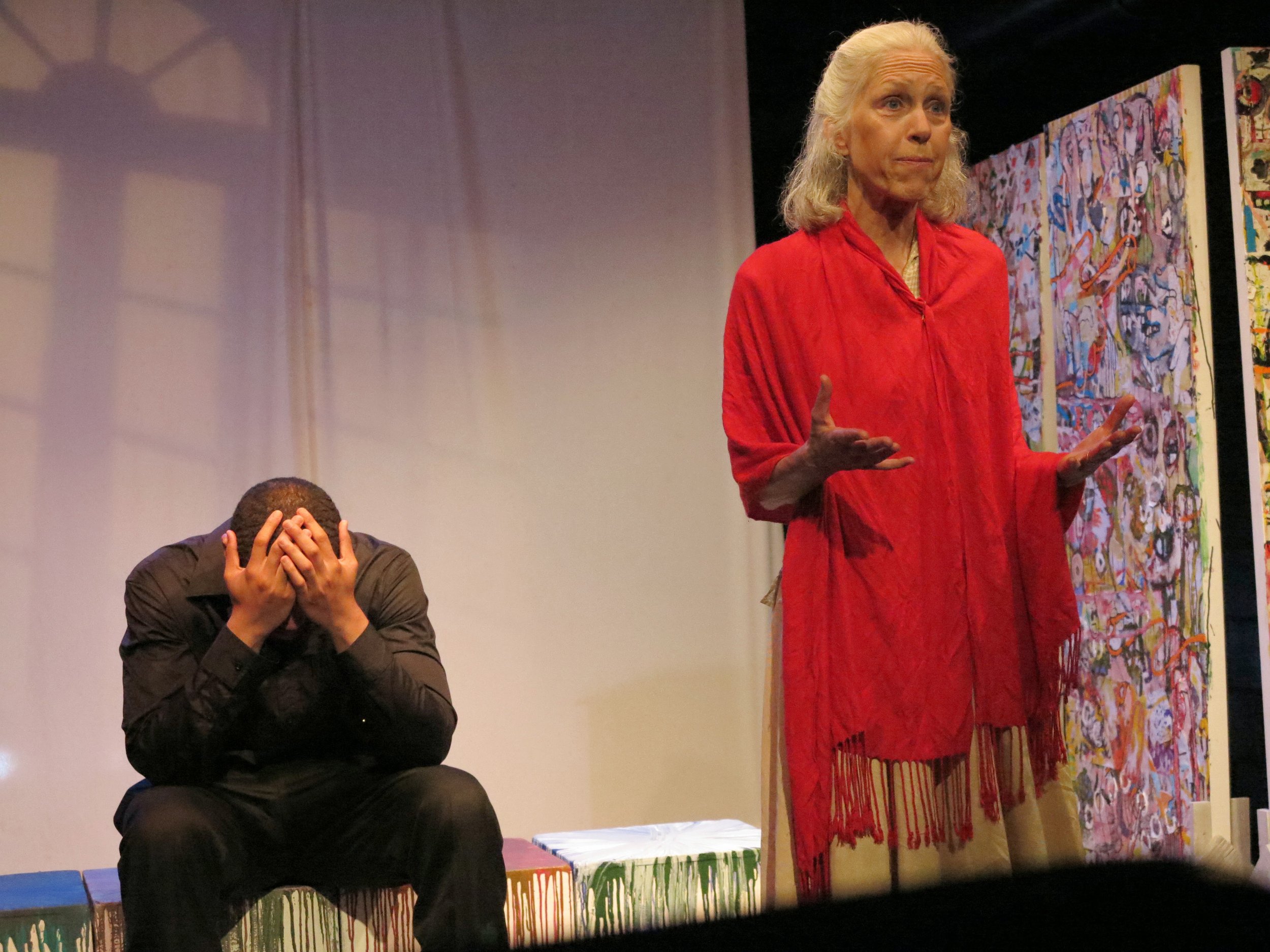White Noise
Theater for the New City, NYC, June-July 2013
(this play has been renamed: "Twister: It Happened in Detroit")
Tim, an African American painter, has developed a “ministry of the arts” by basing his work on spiritual masters of the past. He has been brought to Detroit to exhibit his work in a church gallery. The church is having financial problems, however, and it was unclear that they would be able to pay his way, so they accessed monies from Northrup-Grumman, where Dick, the chairman of the Church Arts Board, once worked. Tim is astounded to learn that his trip is being underwritten by a munitions maker.
Immediately after learning this information, however, he finds out that his hostess Sally – where he will stay for the weekend while in Detroit – was raped two years ago. Lilac, one of the art committee leaders, keeps insisting that the rapist was black, but she is continually corrected by those around her: he was a white man of Swedish extraction. Joan, another hostess, who is in charge of shepherding Tim through his time in Detroit, is a highly-sexed 50-something woman, who conflates sex and mystical realization. Tim, who is at first mature and helpful, slowly finds all of the sexual energy breaking through his calm spiritual veneer, and assaulting him with his own sexual anxieties and spiritual uncertainties.
Simone Weil – an historical figure, 20th century prophet on whose thought Tim’s art is based – shows up (a figment of Tim’s imagination) in scanty clothes to mock and tease Tim. Dick and Lilac, 70-something leaders of the church community, reappear onstage with Joan and Tim (though not interacting with them), and all four have a strange, four-way conversation about sex, desire and spirituality.
Finally, the last scene takes place deep in the night at Sally’s house, when neither Sally nor Tim can sleep. Their interaction quickly heads into the surreal, where it is not exactly clear what part of the action is taking place between the two, and what solely in Tim’s head. Simone reappears and is apperceived by Sally, who finds the apparition fascinating. After Simone exits, Sally assumes the role of Tim’s mentor/tormentor. Finally, Tim can take it no more and exits to the bathroom, where he finds dubious consolation alone, somewhere between a “faith in faith” and the lost.Tim, an African American painter, has developed a “ministry of the arts” by basing his work on spiritual masters of the past. He has been brought to Detroit to exhibit his work in a church gallery. The church is having financial problems, however, and it was unclear that they would be able to pay his way, so they accessed monies from Northrup-Grumman, where Dick, the chairman of the Church Arts Board, once worked. Tim is astounded to learn that his trip is being underwritten by a munitions maker.
Immediately after learning this information, however, he finds out that his hostess Sally – where he will stay for the weekend while in Detroit – was raped two years ago. Lilac, one of the art committee leaders, keeps insisting that the rapist was black, but she is continually corrected by those around her: he was a white man of Swedish extraction. Joan, another hostess, who is in charge of shepherding Tim through his time in Detroit, is a highly-sexed 50-something woman, who conflates sex and mystical realization. Tim, who is at first mature and helpful, slowly finds all of the sexual energy breaking through his calm spiritual veneer, and assaulting him with his own sexual anxieties and spiritual uncertainties.
Simone Weil – an historical figure, 20th century prophet on whose thought Tim’s art is based – shows up (a figment of Tim’s imagination) in scanty clothes to mock and tease Tim. Dick and Lilac, 70-something leaders of the church community, reappear onstage with Joan and Tim (though not interacting with them), and all four have a strange, four-way conversation about sex, desire and spirituality.
Finally, the last scene takes place deep in the night at Sally’s house, when neither Sally nor Tim can sleep. Their interaction quickly heads into the surreal, where it is not exactly clear what part of the action is taking place between the two, and what solely in Tim’s head. Simone reappears and is apperceived by Sally, who finds the apparition fascinating. After Simone exits, Sally assumes the role of Tim’s mentor/tormentor. Finally, Tim can take it no more and exits to the bathroom, where he finds dubious consolation alone, somewhere between a “faith in faith” and the lost.
Theater for the New City
Cast
Matthew Nared (Tim)
Carol Beaugard (Joan)
Susan O'Doherty (Sally)
Daniel Abse (Dick)
Emily Ward (Lilac)
Gabrielle Young (Simone Weil)
Desiree Miller (Cellist)
Crew
Moema Umann (Director)
Rodrigo Fisher (Assistant Director)
Liz Higgins (Choreographer)
Angelica Borrero (Set Designer)
Alexander Bartenieff (Lighting Designer)
Sylvana Carmella (Costume Design)
Larissa Dzegar (Stage Manager)
Juliano Chiquetto (Media)
Nina Raquel (Production Assistant)
Jonathan Slaff (Public Relations)

Carol Beaugard (Joan) and Matt Nared (Tim)

Susan Doherty (Sally)

Emily Ward (Lilac) and Daniel Abse (Dick)

Daniel Abse (Dick), Emily Ward (Lilac), Carol Beaugard (Joan) and Matt Nared (Tim)

Gabrielle Young (Simone Weil)

Daniel Abse (Dick), Emily Ward (Lilac), Carol Beaugard (Joan) and Matt Nared (Tim)

Susan Doherty (Sally) and Carol Beaugard (Joan)

Susan Doherty (Sally), Matt Nared (Tim) and Carol Beaugard (Joan)

Gabrielle Young (Simone Weil) and Matt Nared (Tim)

Emily Ward (Lilac) and Daniel Abse (Dick)

Matt Nared (Tim) and Susan Doherty (Sally)

Gabrielle Young (Simone Weil), Matt Nared (Tim) and Susan Doherty (Sally)

Susan Doherty (Sally) and Matt Nared (Tim)
